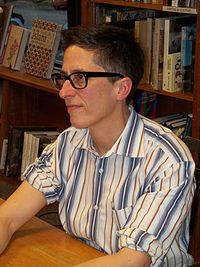
Photo from wikipedia
espanolAntecedentes y objetivo Los pacientes con talasemia mayor (TM) y enfermedad de celulas falciformes (ECF) en Espana se han empezado a contabilizar desde la creacion del registro espanol de hemoglobinopatias… Click to show full abstract
espanolAntecedentes y objetivo Los pacientes con talasemia mayor (TM) y enfermedad de celulas falciformes (ECF) en Espana se han empezado a contabilizar desde la creacion del registro espanol de hemoglobinopatias (REHem). El objetivo del trabajo es actualizar los datos publicados previamente, tras el aumento de casos por la inclusion de adultos y la introduccion del cribado neonatal en casi todo el pais. Material y metodos Estudio observacional, descriptivo, multicentrico y ambispectivo, que incluye pacientes con hemoglobinopatias registrados en REHem, iniciado en enero de 2014 y de seguimiento anual. Los datos presentados corresponden hasta el 31 de diciembre de 2017. Resultados Se recogieron 959 pacientes. Se registraron 75 casos de talasemia (62 TM), 826 de ECF y 58 de otro tipo de hemoglobinopatias. El motivo de diagnostico principal en la TM fue la clinica de anemia (70,6%), con una media de edad al diagnostico de 0,7 anos; en la ECF fue el cribado neonatal (33,1%), con una media de edad al diagnostico de 2,7 anos; 26 pacientes con TM (41,9%) y 30 con ECF (3,6%) fueron sometidos a trasplante. Hubo 2 fallecimientos (3,2%) con TM y 19 (2,3%) con ECF. La supervivencia global fue del 96,7% en la TM y del 97,5% en la ECF a los 15 anos. Conclusiones Desde la publicacion previa y tras la difusion del cribado neonatal, el metodo diagnostico mas frecuente, en la mayoria de comunidades autonomas, y la inclusion de pacientes adultos al registro, el REHem se ha visto incrementado en mas de 240 casos, llegando hasta un total de 959 registros. EnglishBackground and objective Patients with thalassaemia major (TM) and sickle cell disease (SCD) in Spain have been counted since the creation of the Spanish registry of haemoglobinopathies (REHem). The objective of this paper is to update the published data after the increase in cases due to the inclusion of adults and introduction of new-born screening in almost the whole country. Material and methods An observational, descriptive, multicentre and ambispective study that included patients with haemoglobinopathies registered in the REHem, started in January 2014 and followed up annually. The data presented correspond until December 31, 2017. Results Nine hundred and fifty-nine patients were collected. There were 75 cases of thalassaemia (62 TM), 826 of ECF and 58 of other types of haemoglobinopathies. The main diagnostic reason in the TM cohort was anaemia symptoms (70.6%), with a mean age at diagnosis of .7 years; in the SCD cohort it was neonatal screening (33.1%), with a mean age at diagnosis of 2.7 years; 26 patients with TM (41.9%) and 30 with SCD (3.6%) underwent a transplant. There were 2 deaths (3.2%) with TM and 19 (2.3%) with SCD. Overall survival was 96.7% in the TM and 97.5% in the SCD cases at 15 years. Conclusions Since the previous publication and after the diffusion of new-born screening, the most frequent diagnostic method, to the majority of autonomous regions, and the inclusion of adult patients to the registry, the REHem has increased by more than 240 cases, reaching a total of 959 records.
Journal Title: Medicina Clinica
Year Published: 2020
Link to full text (if available)
Share on Social Media: Sign Up to like & get
recommendations!